Long Term Sediment Modification Effects after Applications of P Inactivation Method in Meromictic Lake (Starodworskie Lake, Olsztyn Lakeland, Poland)
Abstract
1. Introduction
2. Materials and Methods
3. Results and Discussion
3.1. Sediment Chemical Composition
3.2. Changes in Sediment Chemical Composition and Near-Bottom and Interstitial Water Induced by P Inactivation
4. Conclusions
Author Contributions
Funding
Institutional Review Board Statement
Informed Consent Statement
Data Availability Statement
Acknowledgments
Conflicts of Interest
References
- Schindler, D.W. The dilemma of controlling cultural eutrophication of lakes. Proc. R. Soc. B 2012, 279, 4322–4333. [Google Scholar] [CrossRef]
- Kowalczewska-Madura, K.; Dondajewska, R.; Gołdyn, R.; Kozak, A.; Messyasz, B. Internal phosphorus loading from bottom sediment of a dimictic lake during its sustainable restoration. Water Air Soil Pollut. 2018, 229, 280. [Google Scholar] [CrossRef]
- Tórz, A.; Bonisławska, M.; Rybczyk, A.; Nędzarek, A.; Tański, M. Susceptibility to degradation, the causes of degradation, and trophic state of three lakes in North-West Poland. Water 2020, 12, 1635. [Google Scholar] [CrossRef]
- Tandyrak, R. Ewolucja Miksji I Stan Troficzny Jeziora Starodworskiego Na Tle Warunków Klimatycznych I Postępującej Urbanizacji (Evolution of Mictic and Trophic State of Lake Starodworskie on The Background of Climate and Urbanization); UWM in Olsztyn Publishing House: Olsztyn, Poland, 2017; pp. 1–118. [Google Scholar]
- Mesman, J.P.; Stelzer, J.A.A.; Dakos, V.; Goyette, S.; Jones, I.D.; Kasparian, J.; McGinnis, D.F.; Ibelings, B.W. The role of internal feedbacks in shifting deep lake mixing regime under a warming climate. Freshw. Biol. 2021. [CrossRef]
- Boehrer, B.; von Rohden, C.; Schultze, M. Physical features of meromictic lakes: Stratification and circulation. In Ecology of Meromictic Lakes. Serie Ecological Studies. Analysis and Synthesis; Gulati, R.D., Zadereev, E.S., Degermendzhi, A.G., Eds.; Springer International Publishing AG: Cham, Switzerland, 2017; Volume 228, pp. 15–34. [Google Scholar]
- Schultze, M.; Boehrer, B.; Wendt-Potthoff, K.; Katsev, S.; Brown, E.T. Chemical Settings and Biogeochemical Reaction in Meromictic Lakes. In Ecology of Meromictic Lakes. Serie Ecological Studies. Analysis and Synthesis; Gulati, R.D., Zadereev, E.S., Degermendzhi, A.G., Eds.; Springer Interantional Publishing AG: Cham, Switzerland, 2017; Volume 228, pp. 35–60. [Google Scholar]
- Zadereev, E.S.; Boehrer, B.; Gulati, R.D. Introduction: Meromictic Lakes, Their Terminology and Geographic Distribution. In Ecology of Meromictic Lakes. Serie Ecological Studies. Analysis and Synthesis; Gulati, R.D., Zadereev, E.S., Degermendzhi, A.G., Eds.; Springer Interantional Publishing AG: Cham, Switzerland, 2017; Volume 228, pp. 1–14. [Google Scholar]
- Douglas, G.B.; Hamilton, D.P.; Robb, M.S.; Pan, G.; Spears, B.; Lürling, M. Guiding principles for the development and application of solid-phase phosphorus adsorbents for freshwater ecosystems. Aquat. Ecol. 2016, 50, 385–405. [Google Scholar] [CrossRef]
- Lürling, M.; Mucci, M. Mitigating eutrophication nuisance: In-lake measures are becoming inevitable in eutrophic waters in the Netherlands. Hydrobiologia 2020, 847, 4447–4467. [Google Scholar] [CrossRef]
- Cooke, G.D.; Welch, E.B.; Peterson, S.A.; Nichols, S.A. Restoration and Management of Lakes and Reservoirs; CRC Press, Taylor and Francis Group, LLC: Abingdon, UK, 2005. [Google Scholar]
- Łopata, M.; Augustyniak, R.; Grochowska, J.; Parszuto, K.; Tandyrak, R. Phosphorus removal with coagulation processes in five low buffered lakes-a case study of mesocosm research. Water 2019, 11, 1812. [Google Scholar] [CrossRef]
- Lewandowski, J.; Schauser, I.; Hupfer, M. Long term effect of phosphorus precipitation with alum in hypereutrophic Lake Süsser See (Germany). Water Res. 2003, 37, 3194–3204. [Google Scholar] [CrossRef]
- Huser, B.J. Aluminum application to restore water quality in eutrophic lakes: Maximizing binding efficiency between aluminum and phosphorus. Lake Reserv. Manag. 2017, 33, 143–151. [Google Scholar] [CrossRef]
- Agstram-Norlin, O.; Lannegård, E.E.; Futter, B.J.; Huser, B.J. Optimization of aluminum treatment efficiency to control internal phosphorus loading in eutrophic lakes. Water Res. 2020, 185, 116150. [Google Scholar] [CrossRef] [PubMed]
- Welch, E.B.; Gibbons, H.L.; Brattebo, S.K.; Corson-Riker, H.A. Distribution of aluminum and phosphorus fractions following alum treatments in a large shallow lake. Lake Reserv. Manag. 2017, 33, 198–204. [Google Scholar] [CrossRef]
- Welch, E.B.; Gibbons, H.L.; Brattebo, S.K.; Corson-Riker, H.A. Progressive conversion of sediment mobile phosphorus to aluminum phosphorus. Lake Reserv. Manag. 2017, 33, 205–210. [Google Scholar] [CrossRef]
- Lossow, K.; Gawrońska, H.; Mientki, C.; Wiśniewski, G.; Łopata, M. Jeziora Olsztyna. Stan Troficzny, Zagrożenia (Lakes of Olsztyn. Trophic State, Threats); Edycja, S.C.: Olsztyn, Poland, 2005; pp. 85–99. (In Polish) [Google Scholar]
- Tandyrak, R. Badanie Efektywności Rekultywacji Jeziora Starodworskiego Metodą Inaktywacji Fosforu. Ph.D. Thesis, UWM, Olsztyn, Poland, June 2000. [Google Scholar]
- Gawrońska, H. Wymiana fosforu i azotu pomiędzy osadami a wodą w jeziorze sztucznie napowietrzanym (The exchange of phosphorus and nitrogen between sediments and water in an artificially aerated lake). Acta Acad. Agricult. Tech. Olst. Protectio Aquarum Piscat. 1994, 19, 3–50. [Google Scholar]
- Hermanowicz, W.; Dożańska, W.; Dojlido, J.; Koziorowski, B. Fizyczno-Chemiczne Badanie Wody I Ścieków (Physical and Chemical Analysis of Water and Sewage); Arkady: Warszawa, Poland, 1976. (In Polish) [Google Scholar]
- Hermanowicz, W.; Dożańska, W.; Dojlido, J.; Koziorowski, B.; Zerbe, J. Fizyczno-Chemiczne Badanie Wody I Ścieków (Physical and Chemical Analysis of Water and Sewage); Arkady: Warszawa, Poland, 1999. (In Polish) [Google Scholar]
- Augustyniak, R.; Grochowska, J.; Łopata, M.; Parszuto, K.; Tandyrak, R.; Tunowski, J. Sorption properties of the bottom sediment of a lake restored by phosphorus inactivation method 15 years after the termination of lake restoration procedures. Water 2019, 11, 2175. [Google Scholar] [CrossRef]
- Psenner, R.; Boström, B.; Dinka, M.; Pettersson, K.; Pucsko, R.; Sager, M. Fractionation of phosphorus in suspended matter and sediment. Sediment phosphorus group: Working group summaries and proposals for future research. Arch. Hydrobiol. Beih. Ergebn. Limnol. 1988, 30, 98–110. [Google Scholar]
- The location of Starodworskie Lake. Available online: www.google.pl/maps (accessed on 15 February 2021).
- Tibco Inc. Statistica 13.3. Software Package; Tibco Inc.: Palo Alto, CA, USA, 2017. [Google Scholar]
- Choiński, A. Zarys Limnologii Fizycznej Polski (Treatise on Physical Limnology of Poland); UAM Publishing House: Poznań, Poland, 1995; pp. 1–298. (In Polish) [Google Scholar]
- Januszkiewicz, T.; Czerniakowska, M.; Rochwerger, A. Chemistry of surficial bottom sediments of Długie Lake at Olsztyn (Chemizm powierzchniowej warstwy osadów dennych Jez. Długiego w Olsztynie). Acta Acad. Agricul. Techn. Olst. Protectio Aquarum Piscat. 1985, 14, 9–25. (In Polish) [Google Scholar]
- Hartikainen, H.; Pitkänen, M.; Kairesalo, T.; Tuominen, L. Co-occurrence and potential chemical competition of phosphorus and silicon in lake sediment. Water Res. 1996, 30, 2472–2478. [Google Scholar] [CrossRef]
- Rydin, E. Potentially mobile phosphorus in Lake Erken sediment. Water Res. 2000, 34, 2037–2042. [Google Scholar] [CrossRef]
- Grochowska, J.; Augustyniak, R.; Łopata, M.; Parszuto, K.; Tandyrak, R.; Płachta, A. From saprotrophic to clear water status: The restoration path of a degraded urban lake. Water Air Soil Pollut. 2019, 230, 94. [Google Scholar] [CrossRef]
- Risgaard-Petersen, N.; Nielsen, L.P.; Rysgaard, S.; Dalsgaard, T.; Meyer, R.L. Application of the isotope pairing technique in sediments where annamox and denitrification coexist. Limnol. Oceanogr. Methods 2003, 1, 63–73. [Google Scholar] [CrossRef]
- Varjo, E.; Liikanen, A.; Salonen, V.P.; Martikainen, P.J. A new gypsum-based technique to reduce methane and phosphorus release from sediments of eutrophied lakes (Gypsum treatment to reduce internal loading. Water Res. 2003, 37, 1–10. [Google Scholar] [CrossRef]
- Caraco, N.F.; Cole, J.J.; Likens, G.E. Phosphorus release from anoxic sediments: Lakes, that break the rules. Verh. Inter. Ver. Limnol. 1991, 24, 2985–2988. [Google Scholar] [CrossRef]
- Kowalczewska-Madura, K.; Dondajewska, R.; Gołdyn, R. Seasonal changes of phosphorus release from the bottom sediment of Rusałka Lake during restoration processes. Ecol. Chem. Eng. A 2011, 18, 219–224. [Google Scholar]
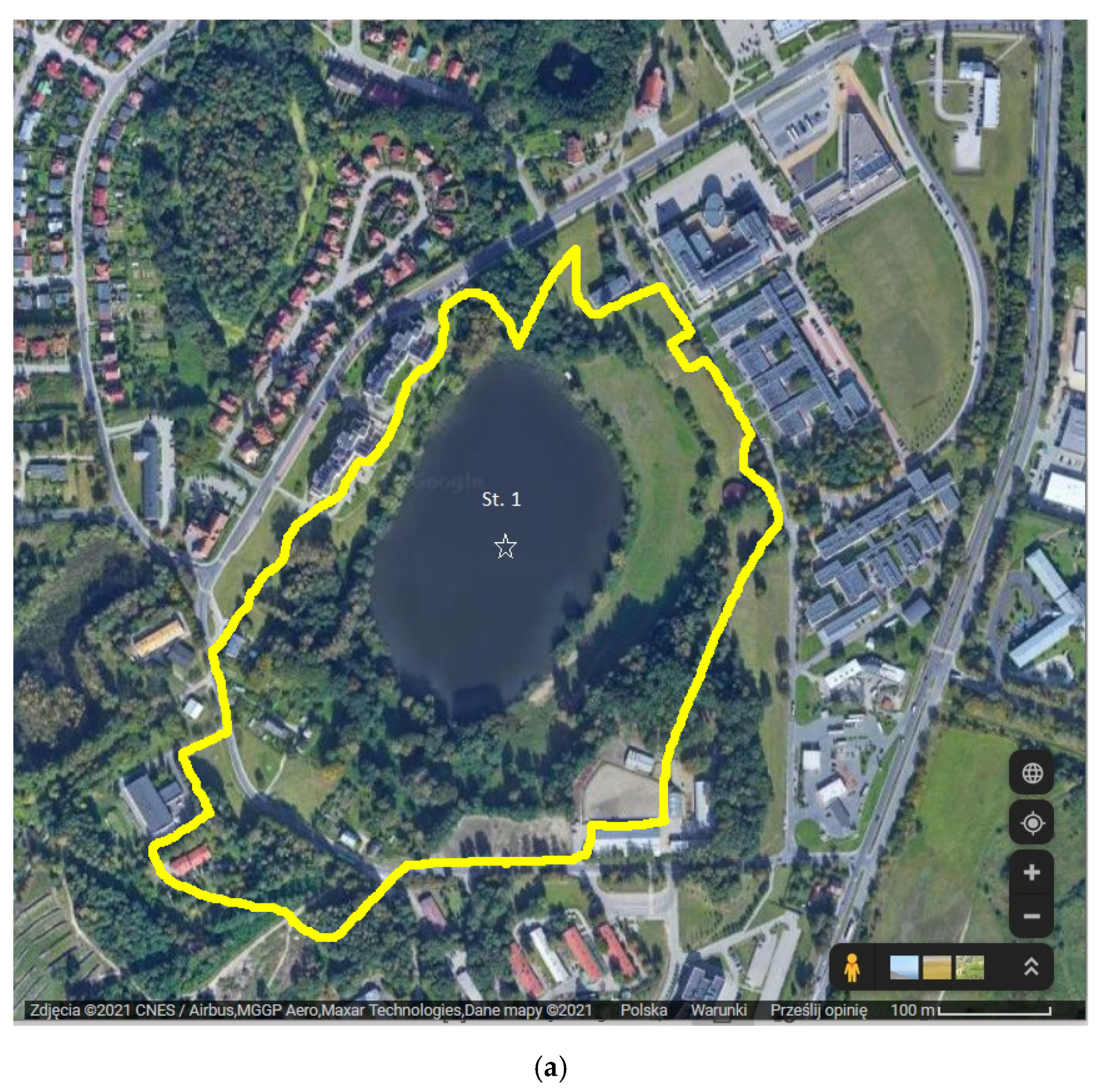
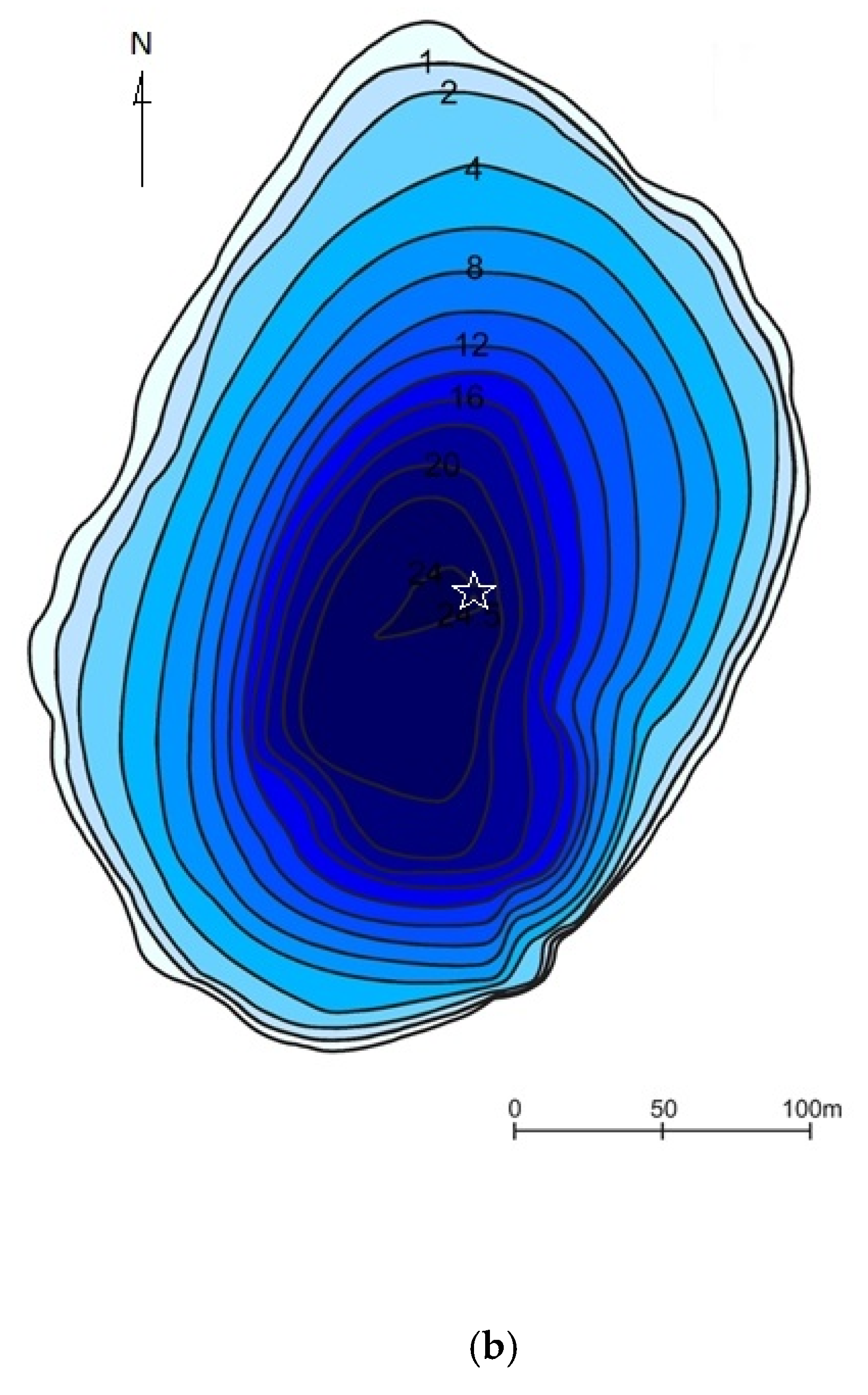
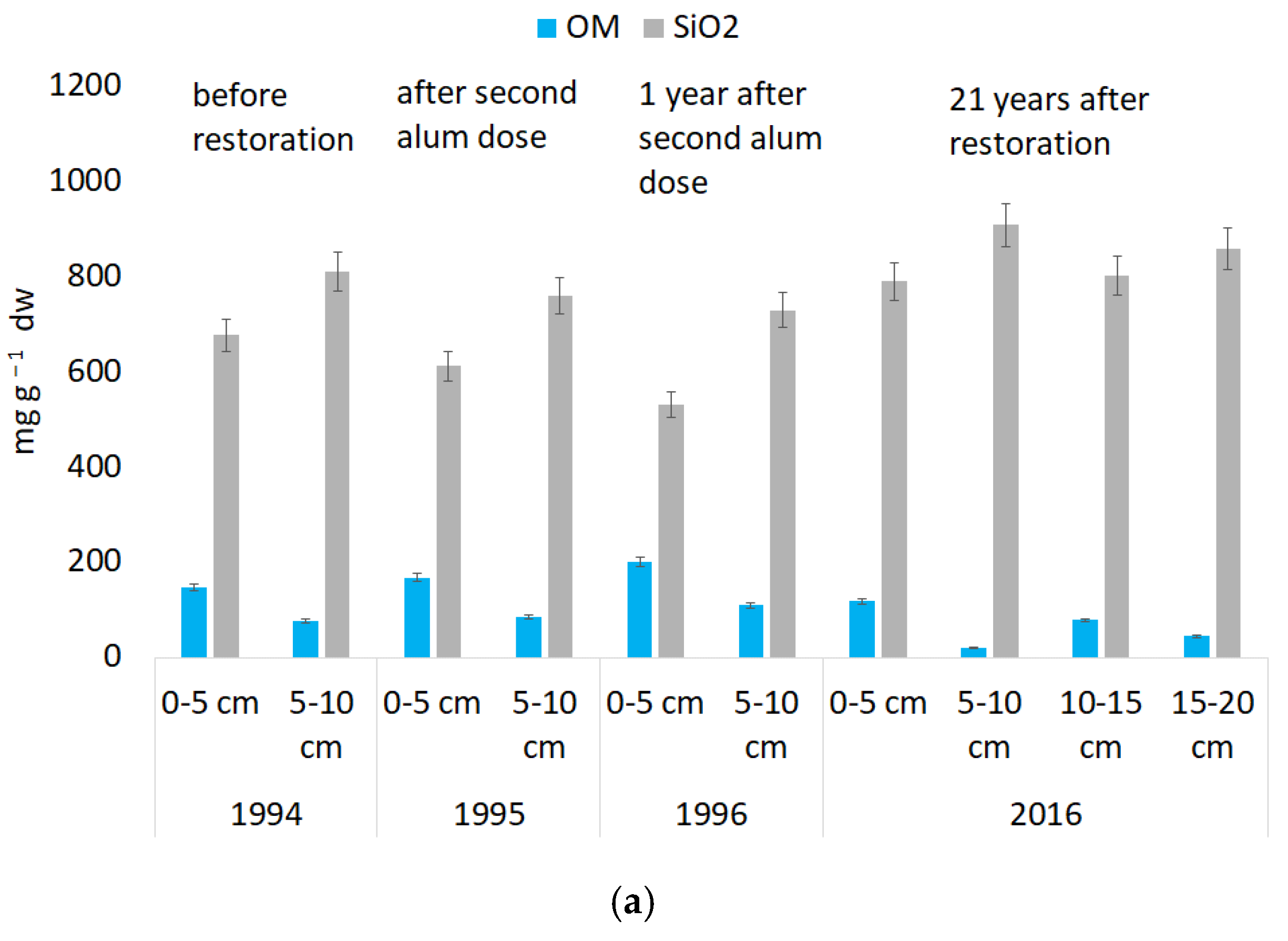
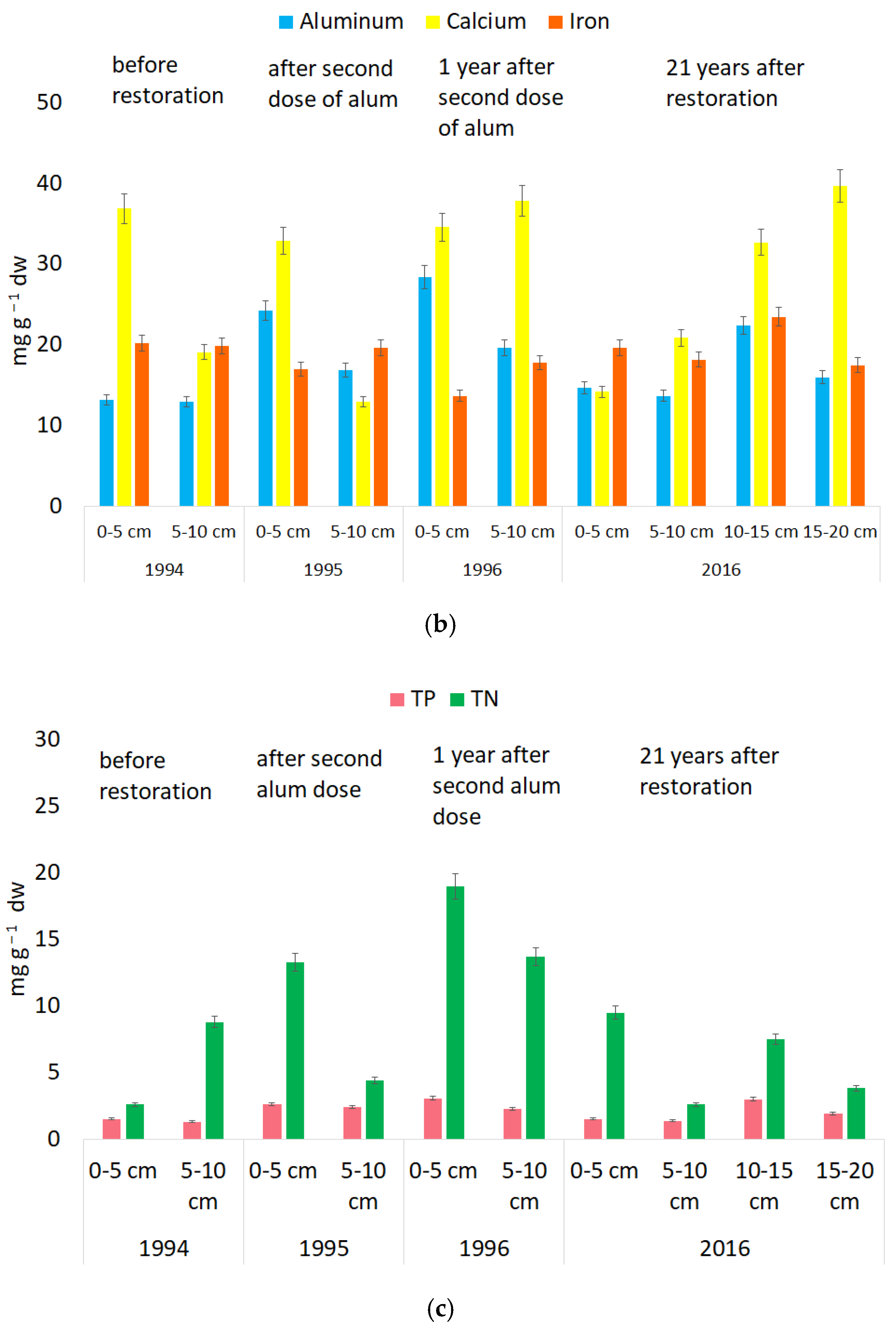
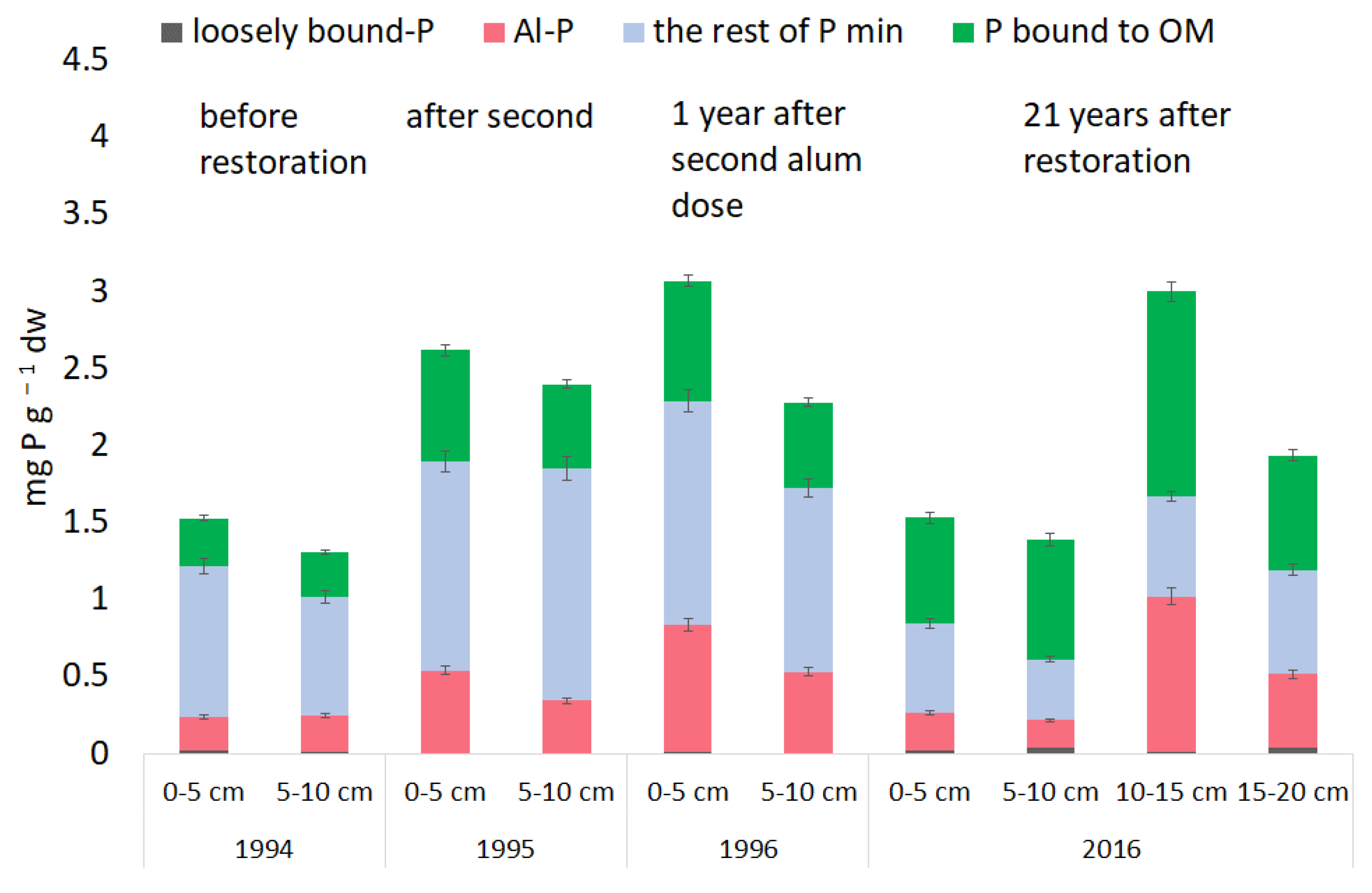

| Parameter | Unit | Value |
|---|---|---|
| Location | m a.s.l. | 110.85 |
| Surface area | ha | 5.57 |
| Maximum depth | m | 24.5 |
| Average depth | m | 9.4 |
| Relative depth index | - | 0.1038 |
| Depth index | - | 0.382 |
| Volume | m3 | 522,014 |
| Maximum lenght | m | 341 |
| Maximum width | m | 226 |
| Shoreline lenght | m | 892.0 |
| Shoreline development index | - | 1.07 |
| Parameter | Al | Ca | Fe | OM | SiO2 | TP |
|---|---|---|---|---|---|---|
| Al | - | - | - | - | - | - |
| Ca | 0.389 | - | - | - | - | - |
| Fe | −0.454 | n.s | - | - | - | - |
| OM | 0.629 | n.s | −0.427 | - | - | - |
| SiO2 | −0.678 | n.s. | 0.503 | −0.860 | - | - |
| TP | 0.921 | 0.369 | n.s. | 0.460 | −0.548 | - |
| TN | 0.782 | n.s. | −0.553 | 0.714 | −0.654 | 0.578 |
Publisher’s Note: MDPI stays neutral with regard to jurisdictional claims in published maps and institutional affiliations. |
© 2021 by the authors. Licensee MDPI, Basel, Switzerland. This article is an open access article distributed under the terms and conditions of the Creative Commons Attribution (CC BY) license (https://creativecommons.org/licenses/by/4.0/).
Share and Cite
Augustyniak, R.; Tandyrak, R.; Łopata, M.; Grochowska, J. Long Term Sediment Modification Effects after Applications of P Inactivation Method in Meromictic Lake (Starodworskie Lake, Olsztyn Lakeland, Poland). Land 2021, 10, 411. https://doi.org/10.3390/land10040411
Augustyniak R, Tandyrak R, Łopata M, Grochowska J. Long Term Sediment Modification Effects after Applications of P Inactivation Method in Meromictic Lake (Starodworskie Lake, Olsztyn Lakeland, Poland). Land. 2021; 10(4):411. https://doi.org/10.3390/land10040411
Chicago/Turabian StyleAugustyniak, Renata, Renata Tandyrak, Michał Łopata, and Jolanta Grochowska. 2021. "Long Term Sediment Modification Effects after Applications of P Inactivation Method in Meromictic Lake (Starodworskie Lake, Olsztyn Lakeland, Poland)" Land 10, no. 4: 411. https://doi.org/10.3390/land10040411
APA StyleAugustyniak, R., Tandyrak, R., Łopata, M., & Grochowska, J. (2021). Long Term Sediment Modification Effects after Applications of P Inactivation Method in Meromictic Lake (Starodworskie Lake, Olsztyn Lakeland, Poland). Land, 10(4), 411. https://doi.org/10.3390/land10040411








